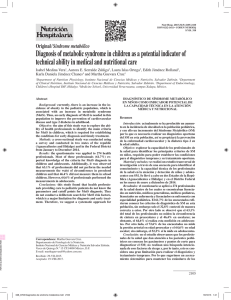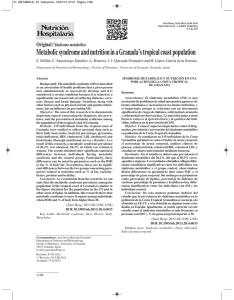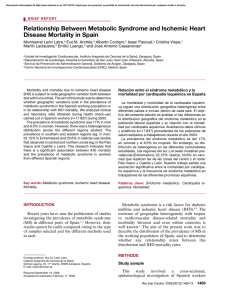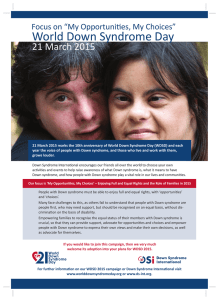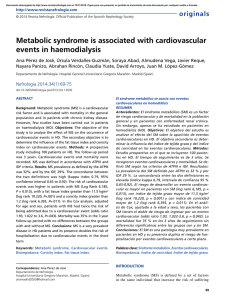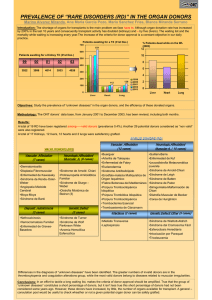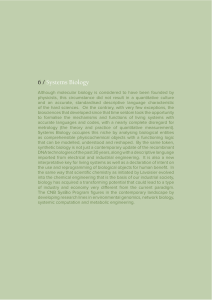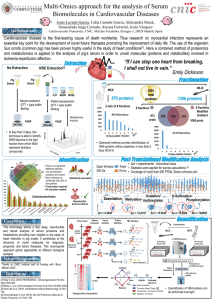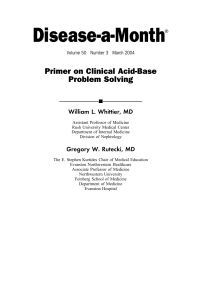Original / Síndrome metabólico Metabolic syndrome and its
Anuncio
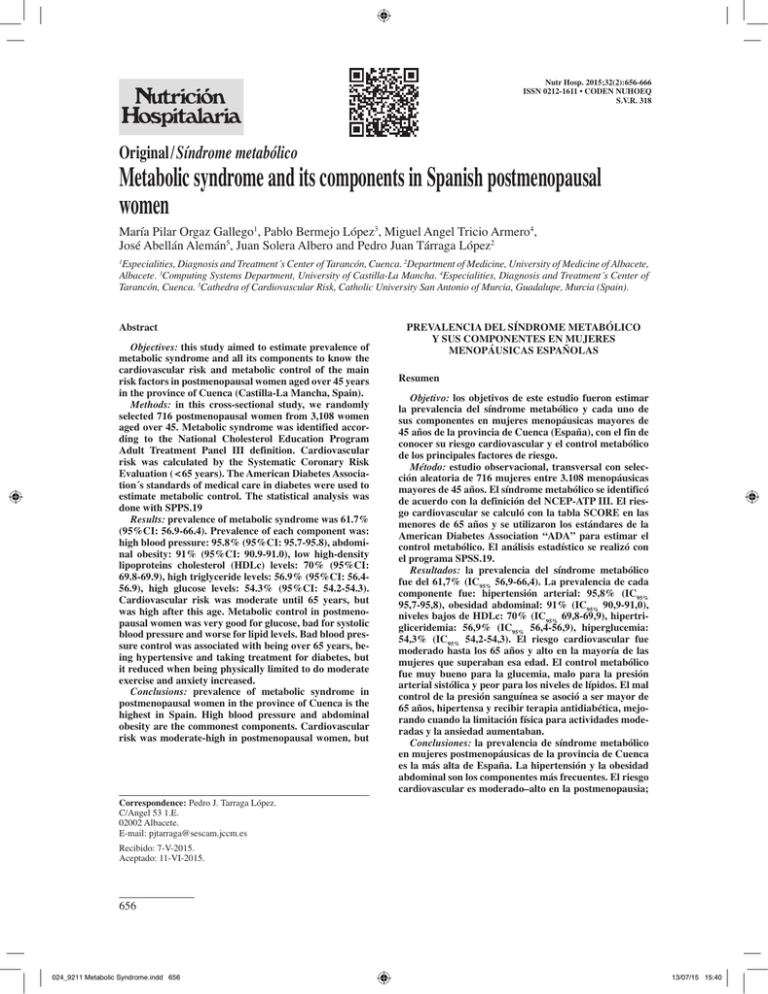
Nutr Hosp. 2015;32(2):656-666 ISSN 0212-1611 • CODEN NUHOEQ S.V.R. 318 Original / Síndrome metabólico Metabolic syndrome and its components in Spanish postmenopausal women María Pilar Orgaz Gallego1, Pablo Bermejo López3, Miguel Angel Tricio Armero4, José Abellán Alemán5, Juan Solera Albero and Pedro Juan Tárraga López2 1 Especialities, Diagnosis and Treatment´s Center of Tarancón, Cuenca. 2Department of Medicine, University of Medicine of Albacete, Albacete. 3Computing Systems Department, University of Castilla-La Mancha. 4Especialities, Diagnosis and Treatment´s Center of Tarancón, Cuenca. 5Cathedra of Cardiovascular Risk, Catholic University San Antonio of Murcia, Guadalupe, Murcia (Spain). Abstract Objectives: this study aimed to estimate prevalence of metabolic syndrome and all its components to know the cardiovascular risk and metabolic control of the main risk factors in postmenopausal women aged over 45 years in the province of Cuenca (Castilla-La Mancha, Spain). Methods: in this cross-sectional study, we randomly selected 716 postmenopausal women from 3,108 women aged over 45. Metabolic syndrome was identified according to the National Cholesterol Education Program Adult Treatment Panel III definition. Cardiovascular risk was calculated by the Systematic Coronary Risk Evaluation ( < 65 years). The American Diabetes Association´s standards of medical care in diabetes were used to estimate metabolic control. The statistical analysis was done with SPPS.19 Results: prevalence of metabolic syndrome was 61.7% (95%CI: 56.9-66.4). Prevalence of each component was: high blood pressure: 95.8% (95%CI: 95.7-95.8), abdominal obesity: 91% (95%CI: 90.9-91.0), low high-density lipoproteins cholesterol (HDLc) levels: 70% (95%CI: 69.8-69.9), high triglyceride levels: 56.9% (95%CI: 56.456.9), high glucose levels: 54.3% (95%CI: 54.2-54.3). Cardiovascular risk was moderate until 65 years, but was high after this age. Metabolic control in postmenopausal women was very good for glucose, bad for systolic blood pressure and worse for lipid levels. Bad blood pressure control was associated with being over 65 years, being hypertensive and taking treatment for diabetes, but it reduced when being physically limited to do moderate exercise and anxiety increased. Conclusions: prevalence of metabolic syndrome in postmenopausal women in the province of Cuenca is the highest in Spain. High blood pressure and abdominal obesity are the commonest components. Cardiovascular risk was moderate-high in postmenopausal women, but PREVALENCIA DEL SÍNDROME METABÓLICO Y SUS COMPONENTES EN MUJERES MENOPÁUSICAS ESPAÑOLAS Resumen Objetivo: los objetivos de este estudio fueron estimar la prevalencia del síndrome metabólico y cada uno de sus componentes en mujeres menopáusicas mayores de 45 años de la provincia de Cuenca (España), con el fin de conocer su riesgo cardiovascular y el control metabólico de los principales factores de riesgo. Método: estudio observacional, transversal con selección aleatoria de 716 mujeres entre 3.108 menopáusicas mayores de 45 años. El síndrome metabólico se identificó de acuerdo con la definición del NCEP-ATP III. El riesgo cardiovascular se calculó con la tabla SCORE en las menores de 65 años y se utilizaron los estándares de la American Diabetes Association “ADA” para estimar el control metabólico. El análisis estadístico se realizó con el programa SPSS.19. Resultados: la prevalencia del síndrome metabólico fue del 61,7% (IC95% 56,9-66,4). La prevalencia de cada componente fue: hipertensión arterial: 95,8% (IC95% 95,7-95,8), obesidad abdominal: 91% (IC95% 90,9-91,0), niveles bajos de HDLc: 70% (IC95% 69,8-69,9), hipertrigliceridemia: 56,9% (IC95% 56,4-56,9), hiperglucemia: 54,3% (IC95% 54,2-54,3). El riesgo cardiovascular fue moderado hasta los 65 años y alto en la mayoría de las mujeres que superaban esa edad. El control metabólico fue muy bueno para la glucemia, malo para la presión arterial sistólica y peor para los niveles de lípidos. El mal control de la presión sanguínea se asoció a ser mayor de 65 años, hipertensa y recibir terapia antidiabética, mejorando cuando la limitación física para actividades moderadas y la ansiedad aumentaban. Conclusiones: la prevalencia de síndrome metabólico en mujeres postmenopáusicas de la provincia de Cuenca es la más alta de España. La hipertensión y la obesidad abdominal son los componentes más frecuentes. El riesgo cardiovascular es moderado–alto en la postmenopausia; Correspondence: Pedro J. Tarraga López. C/Angel 53 1.E. 02002 Albacete. E-mail: pjtarraga@sescam.jccm.es Recibido: 7-V-2015. Aceptado: 11-VI-2015. 656 024_9211 Metabolic Syndrome.indd 656 13/07/15 15:40 systolic blood pressure and lipid profile were unsatisfactorily controlled. Early intervention is necessary to achieve a better risk profile. sin embargo, el control de la hipertensión arterial sistólica y del perfil lipídico es insatisfactorio. Es necesaria una intervención precoz para mejorar su perfil de riesgo. (Nutr Hosp. 2015;32:656-666) (Nutr Hosp. 2015;32:656-666) DOI:10.3305/nh.2015.32.2.9211 DOI:10.3305/nh.2015.32.2.9211 Key words: Metabolic syndrome. Postmenopause. Insulin resistance. Cardiovascular risk. Palabras clave: Síndrome metabólico. Postmenopausia. Insulinorresistencia. Riesgo cardiovascular. Introduction provinces of Cuenca, Ciudad Real, Toledo, Guadalajara and Albacete. Tarancón is the most important city in Cuenca which, in May 2011, had 16,581 inhabitants (49.58% women). Its population is generally young, aged 16-54 years on average, which represents 62.58% of its population. This cross-sectional observational study has been conducted with postmenopausal women aged ≥ 45 in the Basic Primary Healthcare Area of Tarancón. By means of simple probabilistic aleatory sampling, four of all the medical quotas covering the population of Tarancón aged > 14 years were selected to obtain a list of all the women aged ≥ 45. On this list of menopausal women, we checked who complied with the MetS criteria defined by the National Cholesterol Education Program (NECP) Adult Treatment Panel III (ATP III)25. Sample size was deteremined by statistically calculating 368 women. Of the 3,108 women aged ≥ 45 years, 716 were menopausal and 442 had MetS according to ATP III. Forty-two women were excluded as they had a severe pathology, psychiatric or terminal disease, senile demencia, or denied participating in this study. The final sample included 400 women, which is 10% more than the size calculated to foresee possible losses and to increase statistical study power. The distribution in age groups was similar for all the groups as of 55 years of age, so it was quite representative of the original population. During the personal interview, and after obtained informed consent, a clinical record was opened for participants where personal and familial data, anthropometric measures, and blood pressure and analytical test results were recorded. Two surveys were also completed; the Morisky-Green-Levine test on therapeutic compliance and SF-12, an abbreviated version of SF-36, to evaluate quality of life. Data were collected between January 2010 and March 2011. This study was approved by professionals from the Tarancón Medical Centre, and also by the Ethics Committee of the Hospital Virgen de la Luz in Cuenca (Spain). Metabolic syndrome (MetS) groups several metabolic risk factors in the same person for which insulin resistance is the common link1,2, which is important given its magnitude and clinical relevance. In Spain, it affects 1 in every 5 adults and consistently increases with age. Having MetS triples the risk of developing cardiovascular diseases (CVD), and raises the risk of diabetes mellitus type 2 and cardiovascular mortality through all causes3-7. Cardiovascular risk (CVR) is the probability of suffering a fatal coronary event or not over a 10-year period. Primary prevention of CVD focuses on controlling risk factors. The main tool to prevent them is estimating the overall CVR, which conditions the therapeutic objectives and strategies to achieve them. Modifying CVR can lower morbidity and mortality by CVD, especially in high-risk subjects8,9. CVD are the first cause of death in Spanish women, and also in the Spanish Autonomous Community of Castilla La Mancha (INE, 2008)10. Less importance attached to CV risk factors in females, given the belief that oestrogens protect them from CVD, along with gender differences in the clinical and demographic profile and use of therapeutic resources, are evident in serious cases such as heart failure, especially acute coronary syndrome (ACS), make the prognosis of women vs. men worse for such problems, and partly explain the differences observed in morbid-mortality11-14. If we bear in mind that 40% of a women’s life occurs during the menopause15 , the postmenopause is associated with a 60% risk of MetS, and this status increases with age due to the metabolic and hormonal changes that occur in this life stage, such as increased body weight16, central redistribution of fat20 and an unfavourable lipid profile19,21-24, this study more than justified to learn MetS prevalence during the menopause, and the overall CVR these women have, is, especially if faced with a population group that requires priority intervention. Metabolic syndrome Methods Population and sample Castilla La Mancha is the third largest Spanish Autonomous community in Spain. It is located in the central-southern area of the peninsu and comprised the Metabolic syndrome and its components in spanish postmenopausal women 024_9211 Metabolic Syndrome.indd 657 MetS was diagnosed to those who fulfilled 3 of the 5 National Cholesterol Education Program (NECP) Adult Treatment Panel III (ATP III)25 criteria: waist circumference > 88 cm or body mass index (BMI) > 28.8; trygliceride levels ≥ 150 mg/dl or on treatment; high-density lipoproteins cholesterol levels (HDLc) < 50 mg/dl Nutr Hosp. 2015;32(2):656-666 657 13/07/15 15:40 or on treatment; blood pressure (BP) ≥ 130/85mmHg or on treatment; fasting blood glucose levels ≥ 110mg/ dl or on treatment; diagnosed diabetes. Study variables Information about age, age at menarche and menopause, years menopause lasted, type of menopause (natural/iatrogenic), ethnic group, level of education (none/primary/secondary/university studies), profession, job situation (works/unemployed/retired), family background of premature CVD, dyslipidaemia, diabetes or high blood pressure was collected. Anthropometric data were obtained (weight/height/BMI/waste in cm) and systolic/diastolic blood pressure values were recorded in their clinical records, which were all retaken during the personal interview held. Information on lifestyle habits (smokers or not; if so, the smoking index was calculated/alcohol consumption /physical exercise, if so, positive type exercise was included; aerobics or not, and time/day; < 30 min, 30-60 min or > 60 min) was obtained, as were data about concomitant diseases and the usual treatments participants were on. Blood glucose levels, glycated haemoglobin, urea, creatinine, uric acid, fibrinogen, total cholesterol (TC), cholesterol linked to high-density lipoproteins (HDLc), cholesterol linked to low-density lipoproteins (LDLc), Castelli index or ratio (CT/HDLc), triglicerides, testosterone, follicle-simulating hormone, luteinising hormone, thyroid-stimulating hormone, and microalbuminuria in urine were determined. The Morisky-Green-Levine test was used to evaluate therapeutic compliance through four items with yes/no responses:1. Have you ever forgotten to take your medication?; 2.Do you take your medication at the indicated time?; 3. When you feel well, do you stop taking your medication?; 4. If medication ever disagreed with you, did you stop taking it?; anyone who correctly responded to all these items was considered “compliant”; that is to say, anyone who answered no/yes/no/no to the questions above. Data collection Weight in kg and height in cm were determined on scales and by an officially approved SECA Model 700 1021994 height rod, after removing shoes and wearing only light clothing. Body mass index was calculated by means of the Weight (kg)/Height (m)2 formula. Waist circumference was measured with a tape measure. The reference taken was measuring directly on the skin halfway between the antero superior iliac spine and the lower costal margin while breathing out deeply26. Systolic and diastolic blood pressures were taken with an OMRON blood pressure monitoring device, model 705 CP (HEM-705 CP E) OMRON MAT SUSAKA Co. Ltd JAPAN (accuracy of 5 mm) by sui- 658 024_9211 Metabolic Syndrome.indd 658 Nutr Hosp. 2015;32(2):656-666 tably placing the armpiece on the circumference of the woman’s arm. The average of two measurements taken on the left arm after a 10-minute rest while the patient sat down was obtained. For smokers, the smoking index (number of cigarettes smoked per day multiplied by the number of smoking years/20) was calculated to obtain the number of packets of cigarettes smoked per year. The associated pathologies included were high blood pressure, diabetes mellitus, hypercholesterolaemia, hypertriglyceridaemia, CVDs (coronary disease/ ictus/ intermmitent claudication), peripheral venous insufficiency, obesity, osteoarthritis, osteoporosis, thyroid pathology, mental health problems and bronchial pathology, as well as the respective treatments for their processes. The biochemical parameters were determined by venipuncture after at least 8 fasting hours in the laboratory at the Hospital Virgen de la Luz in Cuenca in this order: parameter (analytical method/technique/ equipment): glucose (Enzymatic colorimetric/Hexokinase/Cobas C 711 Roche); glycated haemoglobin (Chromatography/ HPLC/Adams AIC Menarini); urea (Enzymatic colorimetric/Ureasa/Cobas C 711 Roche); creatinine (Kinetic,/Jaffe/Cobas C 711 Roche); uric acid (Enzymatic colorimetric /Uricasa/Cobas C 711 Roche); fibrinogen (-/Calculated from the TP reaction (Clauss fibrinogen correlation)/ACLTOP 700 Izasa); total cholesterol (Enzymatic colorimetric /CHODPAP/Cobas 711 Roche); high-density lipoproteins cholesterol (homogenous enzymatic/Plus 3rd generation/Cobas C 711 Roche); low-density lipoproteins cholesterol (homogenous enzymatic /Plus 2nd generation/Cobas C 711 Roche); triglycerides (Enzymatic colorimetric /GPO-PAP/Cobas C 711 Roche); microalbuminuria (Turbidimetry,/Immunoturbidimetry/ Cobas C 711 Roche); testosterone and follicle-stimulating, luteinising and thyroid-stimulating hormones (Immunoanalysis/Chemiluminescence/Architect i400 Abbott/Roche). Statistical analysis The data analysis was done using the statistical software SPSS, version 19. The results were expressed in frequences and percentages for the qualitative variables, and as means and standard deviations for the quantitative variables. The 95% confidence interval was calculated in the variables of interest. To check the means, a Student’s t-test was used with two samples, while an ANOVA was used with three samples or more. A Z-test was done to compare proportions. The correlation analysis between the qualitative variables used X2 + Phi in binomials and Cramer’s t-test in multinomials and among qualitative variables, Pearson’s or Spearman’s. Linear regression was applied for the related numerical variables, while binary logistic regression was applied to predict the degree of binomial control. María Pilar Orgaz Gallego et al. 13/07/15 15:40 Results Of the 716 menopausal women aged ≥ 45 years, 442 (that is 61.73%; 95%CI: 56.0-66.0, p < 0.05) fulfilled at least three of the five MetS criteria according to NCEPATP III, 2001. Forty-two women were excluded from the study as they had a serious, psychiatric or terminal disease, displayed cognitive deterioration, or denied participating. Their mean age was 66.93(10.49) years. Of the total number, 99.3% were white/Caucasian and 66.8% were housewives. The characteristics of the 400 remaining menopausal women with MetS who composed the final study sample are presented in table I. The prevalence of each MetS component can be seen in figure 1. In the 45-54 age group, the most prevalent factor was abdominal obesity, but it was hypertension for the remaining groups, which affected all the participants aged ≥ 75 years. There were three (48%), four (36%) and five (16%) MetS criteria in each woman. Figure 2 shows the distribution of the criteria per age group. The risk SCORE for low-risk populations, like the Spanish population, in women aged up to 65 years was: low ( < 1%:) in 4.71%, moderate (1-4%) in 93.19%, high (5-9%) in 1.57% and very high ( ≥ 10%) in 0.52% (Figure 3). In the participants aged over 65, risk was stratified using the SEH/SEC (Spanish Hypertension and Cardiology Societies) 2007 table. The results were: for the 66-74 age group, risk was moderate in 7.77%, high for 68.93% and very high in 23.30%; in the ≥ 75 age group, risk was moderate in 7.55%, high for 57.55% and very high in 34.90% (Figure 4). Prevalence of diabetes was 32% (95%CI: 27.4-36.5; p < 0.05). The degree of metabolic control was evaluated with the biochemical results obtained for basal blood glucose (while fasting), glycated haemoglobin (HbA1c), high-density lipoproteins cholesterol (HDLc), low-density lipoproteins cholesterol (LDLc), triglycerides and the Castelli Index or the total cholesterol/HDLc quotient, in accordance with the American Diabetes Association’s guidelines. Figure 5 offers the obtained results. Concomitant pathologies appear in figure 6. The Morisky-Green-Levine test indicated lack of adhering to treatment in 40.75% (99%CI: 34.4-47.0; p < 0.01). When relating compliance and blood pressure control, we found that among those women whose blood pressure was not controlled, 49.25% took their medication and 31.25% did not. Among those women whose blood pressure was controlled, an equal percentage of taking medication and not taking medication (9.75%) was found. We also observed that 21.6% of the women took 0-3 drugs, 59.6% took 4-7 drugs and 19.2% took 8-14 drugs daily. The mean drug consumption among those who correctly took medication was 5.25 vs. 5.59 among those who did not. No significant differences were detected. No correlation was found between therapeutic compliance and level of education, although a higher per- Metabolic syndrome and its components in spanish postmenopausal women 024_9211 Metabolic Syndrome.indd 659 centage of incompliance among women who finished primary education and aged 45-54 years was found if compared to the other age groups. Therapeutic compliance was related with degree of metabolic control, where the following were considered to well controlled: HbA1c < 7%, HDLc < 50 mg/ Table I Characteristics of postmenopausal women with MetS Characteristics Age, years 45-54 55-64 65-74 ≥ 75 n (%) 55 (13.75) 121 (30.25) 118 (29.05) 106 (26.50) Age at menarche Between 12-14 years (60.5) Age at menopause ≤ 50 51-56 ≥ 57 (63) (34.30) (2.80) Postmenopause status years < 5 5-14 ≥ 15 (16) (25.30) (58.70) Education None Primarys Secondary University (31) (56.25) (10.25) (2.50) Job situation Retired Employed Unemployed (77.50) (19.70) (2.80) Family diseases Hypertension (mothers) Diabetes (mothers) Dyslipidaemia (fathers) Cardiovascular disease (fathers) Lifestyle Smokers < 10 cigarettes/day 10-19 “ “ ≥ 20 “ “ Alcohol consumption Physical exercise Aerobic exercise Exercise time/day < 30 minutes 30-60 minutes ≥ 60 minutes 53.50 (36.3) 32.20 (22.8) 18 (10.5) 9.80 (7.8) (13) (26.9) (34.5) (38.4) (9) (69) (99.3) (32.4) (55.4) (12.2) Anthropometry Body mass index ≥ 30 kg/m2 Waist circumference > 88cm (64.8) (86.8) Blood pressure, mmHg Diastolic ≥ 85 Systolic ≥ 130 (36.8) (82.3) Nutr Hosp. 2015;32(2):656-666 659 13/07/15 15:40 Low c-HDL: low levels of High-density lipoproteins cholesterol. 91% 70% m ia H c- yp er H tri yp er gl yc e Lo w O bd om in al Fig. 1.—Prevalence of all the MetS components. H A dl, triglyceride levels < 150 mg/dl, LDLc < 100 mg/dl and blood pressure < 130/85 mmHg. However, the differences observed in those who complied and whose control for these parameters was good or bad were not statistically significant. We found a higher percentage of women who complied for those who obtained a higher risk score, but it was not significant. There was also a higher percentage of compliant women (75%) in the group aged ≥ 75 as opposed to the youngest age group (42.9%), which was significant for the 94.5% CI. A higher percentage of women (26.8%) who did not comply was found among those women who did not receive treatment for hypertension. Moreover, a higher percentage of women who did comply was observed among those who played a greater physical and emotional role; that is, those women who did not do less 98% 91% 92% 88% 80% 71% 67% Women's percentage 54% rid em ia L D ity be s ns io n te yp er H 57% gl yc e Women´s Percentage 96% 69% 60% than they would like for physical (59.3%) or pyschic (66.5%) reasons, or who did not stop doing certain tasks for physical (72.9%) or psychic (72.9%) reasons. The probability of not controlling hypertension properly was found to be 4.7-fold higher among hypertensive women and 3-fold higher if they were taking an antidiabetic treatment. It lowered by half when the degree of physical limitation was raised for moderate efforts, and lowered by 20% as the level of anxiety increased. Discussion In this study we used the NCEP ATP-III definition of MetS 2001 to estimate the prevalence of MetS syndrome in postmenopausal women since it is not only 97% 93% 71% 57% 52% 61% 100% Obesity Hypertension 69% 58% 48% 38% low High Density Lipoproteins cholesterol Hypertriglyceridemia Hyperglycemia/Diabetes mellitus 45-54 years 55-64 years 65-74 years 75 years Fig. 2.—Distribution per age for the MetS criteria. 660 024_9211 Metabolic Syndrome.indd 660 Nutr Hosp. 2015;32(2):656-666 María Pilar Orgaz Gallego et al. 13/07/15 15:40 Table II Variables with a significant association Variables p-value Hypertensive and older than 65 years < 0.001 Housewife and non-smoking < 0.001 Smoker with a high level of education < 0.001 Being older and more limited to moderate activities < 0.001 Obesity and practicing fewer activities than desired < 0.001 High body mass index and having less energy < 0.01 Obesity and being retired < 0.05 Hypertensive and low level of education < 0.05 Hypertensive and more than 25 years of menopause < 0.05 Diabetic and older than 65 years < 0.05 Obesity and older < 0.05 Significant association with < 0.001 for: *Having hypertension and aged > 65 años *Being a housewife and a non-smoker *Being a smoker with a higher level of education *Being older with more limitations for making moderate efforts *Having obesity and doing fewer tasks than desired with p < 0.01 for: *Having a high BMI and feeling less energetic with p < 0.05 for: * Having obesity and being retired * Having hypertension and a lower level of education * Having hypertension and more than 25 years of the menopause * Being diabetic and aged > 65 years * Having obesity and being older a simple and useful instrument to be used in Primary Healthcare, but it is also the most widely used one in epidemiological studies. This allowed us to compare our results with already published ones, although we know that the version modified in 2005 is more sensi- Women´s percentage 45-65 93.19% 4.71% 1.57% 0.52% <1%: Low 1-4%: Moderate 5-9%: High ?10%: Very high Fig. 3.—SCORE risk in menopausal women aged 45-65 with MetS. Metabolic syndrome and its components in spanish postmenopausal women 024_9211 Metabolic Syndrome.indd 661 tive to detect insulin resistance. The present study has found the highest MetS prevalence in Spain, which exceeds that of 57% obtained in Sanlúcar de Barrameda (Cádiz, S Spain) reported by López Suárez et al28. We should bear in mind that these authors used the ATP-III (2005) criteria, whose cut-off point for basal blood glucose levels was 100 mg/dl, instead of the 110 mg/dl cut-of used in our study. It also exceeds the 4050% prevalence found by Alexander29 in the NHANES III study conducted in postmenopausal women , the 32.5% prevalence indicated by Haddock30 in Puerto Rico, and that of Choi-K31 in Korean postmenopausal women ( > 44%) when the same definition was used. Although MetS prevalence varies according to the definition employed, the genuine differences in MetS prevalence among populations are perhaps influenced by life style habits, genetic factors, or the age and gender distribution of the study populations. The present study exclusively studied postmenopausal women because the postmenopause is an independent risk factor for MetS and all its components are associated with a 60% increased risk for MetS, which rises over time during the menopause19,32, as we also observed. In this study, the studied population group (menopausal women) and years elapsed during the menopause (58.70% reported it lasting > 14 years) probably explain the high MetS prevalence found in this study. However, we cannot rule out the possible influence of other factors (genetic, dietary, etc.). Regarding the prevalence of each MetS component, this study found high blood pressure in 96% and abdominal obesity in 91% of the sample, where the latter predominated, as determined by a waist circumference of > 88 cm in the 45-54 age group, along with high blood pressure after the age of 55, which affected 100% of the women aged 75 years or more. We also found an almost constant percentage of low HDLc levels for all the age groups (69-71%), while hyperglycaemia increased with age (from 38% in the youngest age group to 58% in women aged ≥ 75 years) and hypertriglyceridaemia lowered (from 67% in the youngest age group to 48% for ≥ 75 years). This can be explained because hyperglycaemia is significantly associated with age, as is obesity, which is also a determining factor of carbohydrade intolerance and hyperglycaemia/diabetes type 2, while hypertriglyceridaemia is more influenced by diet. Hypertension was also found to be the most prevalent MetS component in the study by Villegas33 in Medellín El Retiro (Colombia) and in the PREVENCAT study of Álvarez Sala et al34 (of 2,649 patients, 51.6% were women of a mean of 64 years, and 89.5% were hypertensive), while obesity predominated in the studies of López Suárez et al28 , Viñes J.J in Navarre35 and Calbo Mayo JM et al in Albacete,36 both in Spain The prevalence of cardiovascular risk factors is high in Spain with a low morbimortality by coronary disease. This phenomenon is related with the PANES study Nutr Hosp. 2015;32(2):656-666 661 13/07/15 15:40 68.93% 57.55% 34.90% 23.30% 7.77% Moderate High Very High 7.55% 66 -74 years Fig. 4.—Cardiovascular risk for > 65 years with MetS (SEH/SEC 2007). 75 years by López Bescos et al37 on angina prevalence and cardiovascular risk factors in different Spanish Autonomous Communities. This study included environmental and protective genetic factors so that risk factors were associated with a more benign slow-developing cardiopathy and with more stable atheromatous plaques; hence the lower incidence of acute myocardial infarction. Perhaps the Mediterranean diet had some influence, particularly the intake of olive oil and red wine38. The cardiovascular risk profile in women deteriorates with the postmenopause. Estimating risk is the cornerstone to prevent CVD,39 which continue to be the first cause of death in the western world, and also in women from Castilla la Mancha (INE 2008). To correctly stratify risk, the SCORE project tables are recommended, which were published in the European Heart Journal in 2003 for low-risk countries. These tables estimate risk of cardiovascular death over a 10-year period (including coronary death and death by a cerebrovascular cause), are based on a cohort with 12 European countries, in which Spain participated40, and include 205,178 people. Knowing the risk allows not only to prioritise the population to intervene in, but to also set the therapeutic objectives and strategies towards achievement41. The study indicated that 52% of the sample presented more than three risk factors (36% fulfilled four MetS diagnosis criteria, and 16% fulfilled five). Even though angina prevalence in Castilla la Mancha fell within the 4.1-6.0% range, it was well below the 7.5% global prevalence for Spain obtained by López Bescos et al.37 According to this study, the accumulation of two/three risk factors explained 32.5% of the variability observed in angina prevalence per Spanish Autonomous Community. The relevance of these data lies in the fact that more than half the women in the study were at increased cardiovascular risk, and were, therefore, at risk of dying since risk of death increases exponentially the larger the number of components present42. This fact was confirmed when stratifying CVR with the SCORE table in the women aged up to 65 years, which resulted in a “moderate” risk of dying over a 10-year period (Score:1-4%). Beyond this age, and after applying the SEH/SEC 2007 tables, this risk became “high” in 68.93% of women aged 66-74, and was 57.55% for those aged ≥ 75 years. A considerable percentage of women presented a “very high” risk (23.3% for the 66-74 age group and 34.9% for women aged ≥ 75 years). Notwithstanding, the women in this study led quite a healthy lifestyle as 87% of them did not smoke, 91% did not drink, and almost 70% did some form of aerobic exercise (99.3%) for 30-60 minutes/day (55.4%). As no thorough diet survey was conducted, we do not know if they followed a Mediterranean diet or not. However a recent study on this diet in an adult Spanish population, called DIMERICA43, demonstrated that the Mediterranean diet is somewhat left to one side, fast food, that pre-cooked, high-calorie meals rich in Table III Predictor variables B Significance Odds Ratio High blood pressure 1.563 P < 0.001 4.774 Antidiabetic treatment 1.123 P < 0.01 3.073 Physically limited to make moderate efforts -.617 P < 0.01 .539 Calm and relaxed -.213 P < 0.05 .808 B0 2.282 P < 0.01 9.794 662 024_9211 Metabolic Syndrome.indd 662 Nutr Hosp. 2015;32(2):656-666 María Pilar Orgaz Gallego et al. 13/07/15 15:40 HbA1c < 7% 83,50% 82,25% Fasting blood glucose (90-130 mg/dl) Triglycerides < 150 mg/dl 66% TAD < 85 mmHg 63,20% HDLc > 50 mg/dl 62% CT/HDLc < 4 57,50% TAS/TAD < 130/85 mmHg 36% TAS < 130 mmHg 17,70% LDLc without ECV < 100 mg/dl LDLc with ECV or DM < 70 mg/dl 7,25% 1,75% HbA1c: Glycosylated Hemoglobin; SBP: Systolic Blood Pressure; DBP: Diastolic Blood Pressure; HDLc: High-density lipoproteins cholesterol; CT: Total cholesterol; LDLc: Low-density lipoproteins cholesterol; ECV: Cardiovascular Disease; DM: Diabetes Mellitus. saturated fat are favoured, and Spanish Autonomous Communities in North of Spain, but not in the Mediterranean basin, better follow the Mediterranean diet. To determine the degree of control of the main risk factors, the metabolic objectives set by the American Diabetes Association were used. An objective was found for more than 82% of the sample for basal blood glucose and HbA1c, considering that the overall prevalence of diabetes was 32% (20% for the 45-54 age group, 27.27% for the 55-64 age group, 40.67% for those aged 66-74 years and 33.96% for people over the age of ≥ 75 years). More than half were adequately controlled for triglycerides (66%), diastolic blood pressure (63.20%), HDLc (62%) and CT/HDLc (57.50%), whereas the worst control results went to systo-diastolic blood pressure (36%), systolic blood pressure (17.70%), LDLc levels, not having a CVD (7.25%) and having been diagnosed a CVD (1.75%). This same distribution was observed for the age groups. This poor blood pressure and lipidic control was also observed in the Eurika Study44 with 7,641 patients from 12 European countries, including Spain, where 48% were male, the mean age was 63 years and 40.1% obtained a high SCORE. When studying the degree of control of cardiovascular risk factors in primary prevention, that is, in patients who presented no CVD, but at least one risk factor, a low degree of control of the main risk factors, and the need to implement modified lifestyle habits, apart from the possibility of requiring pharmacological treatment, were demonstrated. Although the prevalence of each MetS component was high, the most predictive factors for risk in women, like low HDLc levels, hyperglycaemia and hypertriglyceridaemia, were those that obtained a higher percentage of control in that study. Metabolic syndrome and its components in spanish postmenopausal women 024_9211 Metabolic Syndrome.indd 663 Fig. 5.—Distribuction of percentages of the metabolic objectives met for all the parameters analysed in the sample. Blood pressure obtained a similar control percentrage to that reported in the PREVENCAT study (40%) and it coincided with that reported in the PRESCAP study published in 2004, in which 36.1% of patients showed good systolic and diastolic blood pressure control, although the percentage of control was higher for diastolic blood pressure than for systolic blood pressure, which was also the case in our study. We should not forget that our objective figures for blood pressure were more demanding ( < 130/85 mmHg vs. < 140/90 mmHg). Our study found that blood pressure control left quite a lot to be desired and worsened with age, as other studies have indicated45-49. The majority of women in each age group studied herein also showed good control of only 2 or 3 of the risk factors defined for MetS (35-38%). Regarding therapeutic compliance, the Morisky-Green test demonstrated how the percentage of complying individuals increased with age. Nevertheless, the finding that almost 50% of women with blood pressure did not adequately control it, despite them adhering to treatment, leads us to reflect on possible undertreatment, insufficient doses, and even professionals’ therapeutic inertia. At the same time, the fact that 31% of the women reported uncontrolled blood pressure and not complying with treatment means that we have to adopt strategies to improve this situation (good conduct, educational techniques, etc.). Our data coincide with De Frutos Echániz50 insofar as improved compliance with age and number of drugs do not significantly influence this, as Escamilla et al51 also concluded. The percentage of incompliance obtained with the Morisky-Green test was similar to that reported by Nutr Hosp. 2015;32(2):656-666 663 13/07/15 15:40 Obesity 67% Osteoarthritis/ Low Back Pain 63% Hypercholesterolaemia 61% Hypertriglyceridaemia 54% Mental Pathology 33.10% Diabetes Mellitus 32.50% Peripheral Arteriopathy 26.80% Osteoporosis Cardiovascular Disease 24.50% 13.50% Bronchial Disease 10% Thyroid Disease 10% Women's Percentage Puigventós et al52, although, as it is well-known, little agreement has been reached between indirect methods like the Morisky-Green test and the gold standard or table counts. Thus a higher percentage of incompliance than that observed was expected. Márquez Contreras et al53 obtained a similar percentage of compliance to that we report for hypertensive patients, and those mid-/long-term studies about compliance in different hypertensive populations, with more patients and that developed strategies to improve therapeutic adhesion were considered a priority. This is why our study is interested in menopausal women in whom hypertension is the most prevalent risk factor of all the MetS components. However in the above study, “adverse effects” were a very important reason to not adhere to treatment (81.9%). In this study, this fact did not significantly occur in 42% of the women aged 45-54 years, but the association between “feeling well” and non-compliance was highly significant in those women under the age of 65; this coincided with the results obtained by Hasford J,54 who showed that the main reason for dropping treatment was because people felt well55. Conclusions –– MetS prevalence is high during the postmenopause, and increases with age and number of components, where hypertension, abdominal obesity and low HDLc levels are the most prevalent. –– The degree of metabolic control of blood glucose, blood pressure and lipid profile is good, deficient and highly deficient, respectively. 664 024_9211 Metabolic Syndrome.indd 664 Nutr Hosp. 2015;32(2):656-666 Fig. 6.—Concomitant pathologies in menopausal women with MetS. –– Despite compliance coming close to 60%, no significant association was found between compliance and the degree of control of each risk factor of MetS. –– Having the following are predictors of poor blood pressure control: aged > 65 years, hypertension, antidiabetic therapy, less limitation for making moderate efforts and lower level of anxiety. This work has been partially supported by the JCCM under regional project PEII-2014-049-P, and the MECD under national project TIN2013-46638C3-3-P References 1. Reaven GM. Banting lectura 1988. Role of insulin resistance in human disease. Diabetes 1988;37(12):1595-1607. 2. Sanchez Fuentes, D, Budiño Sánchez, M. Síndrome metabólico. Medicine 2008; 10(23):1527-1533. 3. Vera Regitz-Zagrosek, MD, Elke Lehmkuhl, MD, Shokufeh Mahmoodzadeh, PhD. Gender aspects of the role of the Metabolic Síndrome as a risk factor for cardiovascular disease. Gender Medicine 2007;4(B):S162-S177. 4. Grima Serrano, A, León Latre, M, Ordóñez Rubio, B. El síndrome metabólico como factor de riesgo cardiovascular. Rev Esp Cardiol Supl 2005;5:16D-20D. 5. Arenillas, J.F, Moro, M.A, Dávalos, A. The metabolic syndrome and stroke. Stroke 2007;38:2196-2203. 6. Del Álamo Alonso, A. Síndrome metabólico. Guías clínicas 2008;8(44).Available at: http://www.fisterra.com. Accessed June 8, 2011. 7. Ford, E.S. Risk for all-cause mortality, cardiovascular disease, and diabetes associated with metabolic syndrome. A summary of the evidence. Diabetes Care 2005;28: 1769-1778. 8. Yusuf, S, Hawken, S, Öunpun, S, Dans, T, Avezum, A, Lauas, F, et al. Effect of potencially modifiable risk factors associated María Pilar Orgaz Gallego et al. 13/07/15 15:40 9. 10. 11. 12. 13. 14. 15. 16. 17. 18. 19. 20. 21. 22. 23. 24. 25. 26. 27. 28. with myocardial infarction in 52 countries (the INTERHEART study): case-control study. Lancet 2004;364:937-52. Fierro González, D. Estratificación del riesgo cardiovascular (Score), prioridades en prevención de la enfermedad cardiovascular y establecimiento de objetivos terapéuticos. En: Documento de consenso SEMERGEN-SEA. Edicomplet. Grupo Saned 2010;Capítulo 3:31-40. Mortalidad en hombres y mujeres por grandes grupos de causas. National Statistic Institute 2008. Sáez,T, Suárez, C, Blanco, F, Gabriel, R. Epidemiología de las enfermedades cardiovasculares en la población anciana española. Rev Esp Cardiol 1998;51:864-873. Vaccarino, V, Parsons, L; Every NR et al, for the Nacional Registry of Myocardial Infarction II participants: Sex-based differences in early mortality alter myocardial infarction. N Engl J Med 1999;341:217-225. Anguita, M, Alonso, J, Bertomeu, V et al. Proyecto de estudio de la situación de la enfermedad cardiovascular de la mujer en España: conclusiones y recomendaciones finales. Rev Esp Cardiol Supl 2008;8:55D-58D. Moreno Aznar, Luis A. et al. Evidencia científica sobre el papel del yogur y otras leches fermentadas en la alimentación saludable de la población española. Nutr Hosp Dic 2013, vol.28, no.6, p.2039-2089. Stramba-Badiale, M, Priori, SG. Estrategias actuales para reducer el impacto de las enfermedades cardiovasculares en la mujer. Rev Esp Cardiol 2006;59:1190-1193. Millán, S. Samaniego-Sánchez, C.; Romero, A.; Quesada-Granados, J. J.; López-García de la Serrana, H. Metabolic syndrome and nutrition in a Granada’s tropical coast population. Nutr Hosp Aug 2013, vol.28, no.4, p.1190-1194. Morato Hernández, L, Malacara Hernández, JM. Condiciones metabólicas y hormonales en la menopausia. Revista de Endocrinología y Nutrición 2006;14(3):149-155 Krotkwiewski, M, Bjorntorp, P, Sjöströn L, Smith V.. Impact of obesity on metabolism in men and women. Importance of regional adipose tissue distribution. J Clin Invest 1983;72:11501162. Mª Loreto Tárraga Marcos, Nuria Rosich , Josefa María Panisello Royo, Aránzazu Gálvez Casas, Juan P. Serrano Selva, José Antonio Rodríguez-Montes y Pedro J. Tárraga López. Eficacia de las estrategias de motivacion en el tratamiento del sobrepeso y obesidad. Nutr Hosp 2014;30(4):741-748. 1. Pavón de Paz, I., Alameda Hernando, C. and Olivar Roldán, J. Obesidad y menopausia. Nutr Hosp Dic 2006, vol.21, no.6, p.633-637. Carr M. The emergente of the metabolic síndrome with menopause. J Clin Endocrinol Metabol 2003;88(6):2404-2411. Martínez Sesmero, J. M., Bastida, S. and Sánchez-Muniz, F. J. Riesgo cardiovascular y síndrome metabólico en el Estudio Área de Toledo. Nutr Hosp Abr 2009, vol.24, no.2, p.167-175. Riobó Serván, Pilar. Obesity and Diabetes. Nutr Hosp Sept 2013, vol.28, suppl.5, p.138-143. Pilnik, S, Figueroa Casas, P. Síndrome metabólico y menopausia: Fisiopatología, diagnóstico y prevención. Available at: http://www.saegre.org. Accessed June 6 2011. Knoop, RH. Risk factors for coronary artery disease I women. Am J Cardiol 2002; 89:28E-34E. Expert Panel on Detection, Evaluation, and Treatment of High Blood Cholesterol in Adults. Executive summary of the Third Report of the National Cholesterol Education Program (NECP) Expert Panel on Detection, Evaluation, and Treatment of High Blood Cholesterol in Adults (Adult Treatment Panel III). JAMA 2001;285:2486-2497. Rosety-Rodríguez, Manuel; Fornieles, Gabriel; Rosety, Ignacio; Díaz, Antonio J.; Rosety, Miguel A.; Camacho-Molina, Alejandra; Rodríguez-Pareja, A.; Tejerina, A.; Alvero-Cruz, José Ramón; Ordonez, Francisco J. Central obesity measurements predict metabolic syndrome in a retrospective cohort study of postmenopausal women. Nutr Hosp Dec 2013, vol.28, no.6, p.1912-1917. Alejandro López Suárez, Javier Elvira González, Manuel Beltrán Robles, Michael Alwakil, Juan Manuel Saucedo, Antonio Metabolic syndrome and its components in spanish postmenopausal women 024_9211 Metabolic Syndrome.indd 665 29. 30. 31. 32. 33. 34. 35. 36. 37. 38. 39. 40. 41. 42. Bascuñana Quirell, Miguel A Barón Ramos, Fernando Fernández Palacín. Prevalencia de obesidad, diabetes, hipertensión, hipercolesterolemia y síndrome metabólico en adultos mayores de 50 años de SanLúcar de Barrameda. Rev Esp Cardiol 2008;61(11):1150-8. Alexander CM, Landsman PB, Teutsch SM, Haffner SM. NCEP-defined metabolic syndrome, diabetes and prevalence of coronary heart disease among NHANES III participants age 50 years and older. Diabetes 2003;52:1210-4. Haddock L, Pérez C . Prevalence of the metabolic syndrome in a female population: 50 years and older in San Juan, Puerto Rico, 2002-2003. Diabetes 2004;53 (Suppl2):A243:994. Cho YS, Kang JH, Kim SA, Shim KW, Lee HS. Association among serum ferritin, alanine aminotransferasa levels, and metabolic syndrome in Korean postmenopausal women. Metabolism 2005;54:1510-1514. CHO GJ, LEE JH, PARK HT, SHIN JH, HONG SC, KIM T, HUR JY, LEE KW, PARK YK, KIM SH. Postmenopausal status according to years since menopause as an independent risk factor for the metabolic syndrome. Menopause 2008; 15(3):524-529. Bezares-Sarmiento, Vidalma del Rosario; Bacardí-Gascón, Montserrat; Márquez-Rosa, Sara; Molinero-González, Olga; Estrada-Grimaldo, Martha; Jiménez-Cruz, Arturo. Efficacy of social support on metabolic syndrome among low income rural women in Chiapas, México. Nutr Hosp Aug 2013, vol.28, no.4, p.1195-1200. Álvarez Sala LA, Suárez C, Mantilla T, Franch J, Ruilope LM, Banegas JR, Barrios, V. Estudio PREVENCAT; control del riesgo cardiovascular en atención primaria. Med Clin (Barc) 2005; 124(11):406-10. Viñes, J. J; Díez, J; Guembe, M. J; González, P; Amézqueta, C; Barba, J; Sobejano, I; Martínez-Vila, E; Grijalba, A. M; Serrano, M; Moreno, C; Los-Arcos, E; Guerrero, D.. Estudio de riesgo vascular en Navarra: objetivos y diseño. Prevalencia del síndrome metabólico y de los factores mayores de riesgo vascular. An Sist Sanit Navar 2007;30(1):113-124. Calbo Mayo JM1, Terrancle de Juan I, Fernández Jiménez P, Rodríguez Martín MJ, Martínez Díaz V, Santisteban López Y, Navarro Martínez A, Sáez Méndez L, Gómez Garrido J, Moreno Salcedo J, Vera Hernández J, Fuster Lluch O, Beato JL, Bleda JM, Solera Santos J; Grupo de Estudio Síndrome Metabólico de Albacete.. Prevalencia del síndrome metabólico en la provincia de Albacete. Rev Clin Esp 2007; 207(2):64-68. López-Bescós L, Cosín J, Elosúa R, Cabadés A, De los Reyes M, Arós F. en nombre de los investigadores del estudio PANES. Prevalencia de angina y factores de riesgo cardiovascular en las diferentes comunidades autónomas de España: estudio PANES. Rev Esp Cardiol 1999;52(12):1045-1056. Medrano MJ, Cerrato E, Boix R, Delgado-Rodríguez M. Factores de riesgo cardiovascular en la población española: metaanálisis de estudios transversales. Med Clin (Barc) 2005; 124(16):606-612. Yusuf S, Hawken S, Ounpuu S, Dans T, Avezum A, Lanas F, McQueen M, Budaj A, Pais P, Varigos J, Lisheng L, INTERHEART Study Investigators. Effect of potencially modifiable risk factors associated with myocardial infarction in 52 countries (the INTERHEART study): case-control study. Lancet 2004;364:937-52. Brotons C, Royo Bordonada MA, Alvarez Sala L, Armario P, Artiago R, Conthe P, en nombre de Comité Interdisciplinario Español de Riesgo Cardiovascular. Adaptación española de la Guía Europea de Prevención Cardiovascular en España 2004; 34:427-432. González-Jiménez, Emilio, Montero-Alonso, Miguel A. and Schmidt-Río Valle, Jacqueline Proteína-C reactiva COMOmarcador bioquímico de riesgo cardiovascular. Nutr Hosp Dic 2013, vol.28, no.6, p.2182-2187. Alfonso del Río Ligorita, Ignacio J Ferreira Monteroa, José A Casasnovas Lenguasb, Eduardo Alegría Ezquerrac, Martín Laclaustraa, Monserrat Leóna, Alberto Corderoc, Alberto Grimad. Temas de actualidad en cardiología preventiva: el síndrome metabólico. Rev Esp Cardiol Supl 2005; 5:13A-23A. Nutr Hosp. 2015;32(2):656-666 665 13/07/15 15:40 43. Abellán Alemán J, Zafrilla MP, Ramos E, Leal M, Ruilope LM. En representación del Grupo Investigador del estudio DIMERICA. Seguimiento de la dieta mediterránea en la población adulta española. Estudio DIMERICA. 17ª Reunión Nacional SEH-LELHA, Marzo-2012. 44. Banegas, JR; López-García E; Dallongeville, J; Guallar, E; Halcox, JP; Borghi, C. Achievement of treatment goals for primary prevention of cardiovascular disease in clinical practice across Europe: the EURIKA study. Eur Heart J 2011; 32:214352 45. Llisterri Caro JL, Rodríguez Coca GC, Alonso Moreno FJ, Santos Rodríguez JA, Carrasco Carrasco E, Aguirre Rodríguez JC et al, en representación del grupo de trabajo de Hipertensión Arterial de la Sociedad Española de Medicina Rural y generalista (Grupo HTA/SEMERGEN) y de los investigadores del Estudio EVENTO. Control de la hipertensión arterial y de otros factores de riesgo cardiovascular en población de alto riesgo asistida en Atención Primaria. Estudio EVENTO. SEMERGEN 2005;31(2):53-60. 46. Llisterri JL, Rodríguez Roca GC, Alonso Moreno FJ, Lou Arnal S, Divisón Garrote JA, Santos Rodríguez JA. Control de la presión arterial en población hipertensa española atendida en Atención Primaria. Estudio PRESCAP 2002. Med Clin (Barc). 2004; 122(5):165-171 47. Santos J, Rodríguez GC, González-Segura D, Llisterri JL, Alonso FJ, Barrios V. Conducta terapéutica del médico de Atención Primaria en los hipertensos mal controlados de mayor edad. Estudio PRESCAP 2006. Aten Primaria 2007;39(Supl 2):131. 48. Banegas JR, Segura J, Ruilope LM, Luque M, García-Robles R, Campo C; CLUE study Group Investigators. Blood pressure control and physician management of hipertensión in hospital hipertensión units in Spain. Hypertension 2004;43:1338-44. 666 024_9211 Metabolic Syndrome.indd 666 Nutr Hosp. 2015;32(2):656-666 49. Escobar C, Barrios V, Calderón A, JL Llisterri, S. García, G C. Rodríguez-Roca, A. Matale. Diabetes mellitus en población hipertensa asistida en Atención Primaria en España. Grado de control tensional y lipídico. Rev Clin Esp 2007;207(5):221-7. 50. Elena de Frutos Echaniz, Gemma Lorenz Castañé, Carolina Manzotti, Ana Espínola Rodríguez, Ana Rosa Hernández Alonso, Alicia Val Jiménez y Mercedes Retana Puigmartí. Cumplimiento terapéutico en pacientes con enfermedad cardiovascular. Clin Invest Arterioscl 2008;20(1):8-13. 51. Escamilla Fresnadillo, JA; Castañar Niño, O; Benito López, S; Ruiz Gil, E; Burrull Gimeno, M; Sáenz Moya, N. Motivos de incumplimiento terapéutico en pacientes mayores polimedicados, un estudio mediante grupos focales. Aten Primaria 2008;40(2):81-5. 52. Elena de Frutos Echaniz , Gemma Lorenz Castañé , Carolina Manzotti , Ana Espínola Rodríguez , Ana Rosa Hernández Alonso , Alicia Val Jiménez , Mercedes Retana Puigmartí. Cumplimiento terapéutico en el tratamiento de la hipertensión: 10 años de publicaciones en España. Med Clin (Barc) 1997.109:702-706. 53. Márquez Contreras, E; Casado Martínez JJ; De la Figuera Von Wichmann, M; Gil Guillén, V; Martell, N en representación del grupo de cumplimiento de la Sociedad Española de hipertensión –LELHA. El incumplimiento terapéutico en el tratamiento de la hipertensión arterial en España. Análisis de los estudios publicados entre 1984 y 2001. Hipertensión 2002; 19(1):12-6. 54. Hasford, J. Compliance and the Benedit/risk relationship of antihypertensive treatment. J Cardiovasc Pharmacol 1992;20(Suppl6):S30-S34. 55. N. Úbeda, M. Basagoiti, E. Alonso-Aperte y G. Varela-Moreiras. Hábitos alimentarios, estado nutricional y estilos de vida en una población de mujeres menopáusicas españolas. Nutr Hosp Jun 2007, vol.22, no.3, p.313-321. María Pilar Orgaz Gallego et al. 13/07/15 15:40
